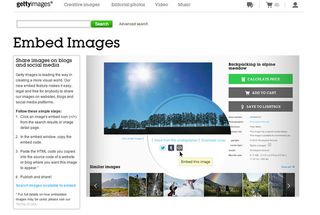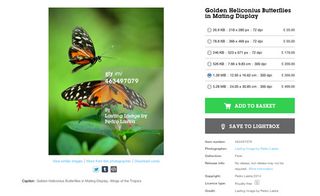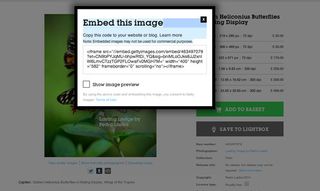
Until yesterday, if you copied an photo from Google Images and put it on your website, blog or Tumblr, and it was licensed by stock image library Getty, you would have been breaking the law. Worse still, the company's advanced image search technology would have meant they would have quickly found out - leaving you open to potential legal action and a massive fine.
Today, that's all changed dramatically.
Faced with the kind of widespread piracy that decimated the music industry a decade ago, Getty has led a tactical retreat down the Spotify route that's great news for website owners. Put simply, it's made around 40 million of its professional photos available for you to embed on your site or blog - without paying a penny.

You're still not allowed to right-click and 'Save As' - to meet Getty's terms you need to use its embed tool, which inserts a credit to the photographer and Getty, and links back to Getty's own site. Essentially, then, much the same as embedding a YouTube video.
Who can use it?
Importantly, this service is only available for non-commercial use. However, the good news is that Getty's definition of commercial is quite specific: "in advertising, promotions or merchandising, or to suggest endorsement or sponsorship".
So it doesn't include, for example, editorial websites, even if they derive income from ads. These fall under the umbrella of 'non-commercial' and can embed the photos for free.
As Craig Peters, senior vice president of business development, content and marketing at Getty Images told Nieman Journalism Lab: "The fact today that a website is generating revenue would not limit the use of the embed. What would limit that use is if they used our imagery to promote a service, a product or their business. They would need to get a license."
Get the Creative Bloq Newsletter
Daily design news, reviews, how-tos and more, as picked by the editors.

The embed capability will be supported anywhere HTML can be posted and users will also be able to share images on major social platforms including Twitter and blogging platforms like Tumblr and WordPress.
How will photographers make money?
So where does this leave photographers? Like the musicians struggling to earn a decent income through sites like Spotify, will they be out of pocket? While it's not yet clear exactly how Getty is going to earn money from giving away its photos, it is investigating a number of potential revenue streams.
Recent initiatives include a partnership with Pinterest, who are paying the stock agency a fee in exchange for metadata about how its images are used, and it's likely similar deals with other social media giants will follow. There's the possibility of advertising being somehow linked to the embeds. And of course, there's the hope that driving traffic back to Getty's site will encourage more people to license the free photos for commercial use - not to mention the fact that the majority of Getty's photos will not be included in the free service.
You'll find full details of the new embed tool on Getty's website.
Liked this? Read these!
- The golden rules for digital icons
- The best free cursive fonts
- Useful and inspiring flyer templates
- The designer's guide to special characters

Thank you for reading 5 articles this month* Join now for unlimited access
Enjoy your first month for just £1 / $1 / €1
*Read 5 free articles per month without a subscription

Join now for unlimited access
Try first month for just £1 / $1 / €1

Tom May is an award-winning journalist and editor specialising in design, photography and technology. Author of the Amazon #1 bestseller Great TED Talks: Creativity, published by Pavilion Books, Tom was previously editor of Professional Photography magazine, associate editor at Creative Bloq, and deputy editor at net magazine. Today, he is a regular contributor to Creative Bloq and its sister sites Digital Camera World, T3.com and Tech Radar. He also writes for Creative Boom and works on content marketing projects.